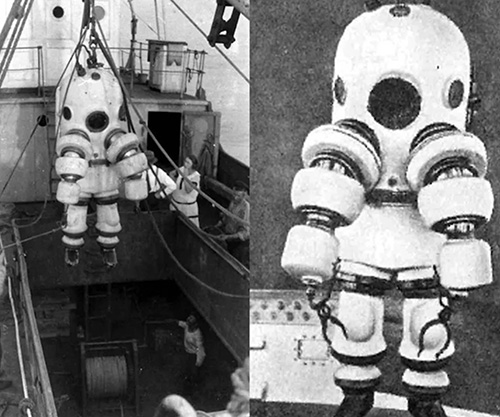In 1878, Alphonse and Theodore Carmagnolle in Marseille, France, developed an armored suit with twenty small portholes and articulated limbs, which they were granted a patent for. It weighed 838 pounds.
This was the first human-shaped atmospheric diving suit (ADS) – meaning that the pressure inside the suit was one atmosphere – the same as at the surface – and therefore the diver wouldn’t have to worry about the dangers of decompression.
Sadly, the suit never worked properly and the joints were never completely waterproof. The original suit is now on display at the French National Navy Museum in Paris.
The same year, Henry Fleuss of London became the very first scuba diver with his invention of the first self-contained underwater breathing apparatus (SCUBA) using compressed oxygen.
He was granted a patent in 1878, and it eliminated the need for a diver to rely on surface-supplied air.
A rubber mask was connected to a rubber airbag, copper oxygen tank, and a scrubber for removing CO2 so that exhaled air could be re-breathed.
This device was originally developed to save trapped miners, but immediately was recognized for its potential underwater.
While it did limit the divers working depth due to the danger of oxygen toxicity, this was a revolutionary design.
The British Navy was the first to train and recruit divers for their purposes, and the US Navy followed suit in a training program in 1882.



This is incredibly fascinating… they look like monsters/machines from an early sci-fi show from the 60s or something!
I’m sure there are probably links between the two. The same fascinations about what lies at the bottom of the ocean could possibly be linked to the same fascinations of space decades later. Exploring the unknown in an inhospitable environment.
I’d love to see some of those suits up close.